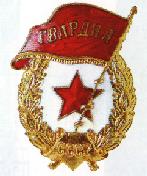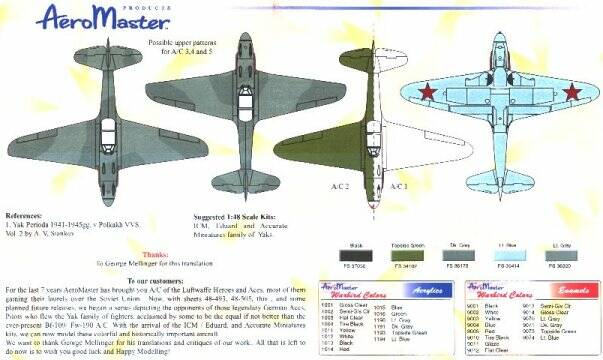Decal Sheet Review: VVS Fighters, Part
VI

In our forthcoming decal sheet review series,
we'll seek to highlight and critique some of the currently available-- and long
past issue-- VVS decal sheets. In this next of a series of installments, we'll
take a look at a new 1:48 scale VVS Fighter sheet.
[All decal sheet scans have been deliberately
skewed and distorted at random angles to dissuade illegal reproduction or Copyright
infringement by any such parties. The precise line and measurement of any specific
marking, therefore, should not be taken literally from these illustrations.]
AeroMaster Products Sheet No. 48-525
"Falcons of the Red Star, Part II"



AeroMaster has released this new sheet of
VVS fighters based on profiles out of A.V. Stankov's book "Porshnevie Istebiteli
Yak; Perioda 1941-45 v Polkakh VVS Vol.2" ("Yak Piston [engined] Fighters
of the 1941-45 Period in VVS Regiments Vol.2") [Ukraina i Mir 1999]. Stankov
has served in the Ukrainian Air Force Command, and is a technical consultant
to several journals and other publications on modern VVS subjects. Alas, he
has no specific expertise in Great Patriotic War era subjects, and this fact
is reflected in the volume at hand.
Stankov was clever in retrieving photographs from collections
that are unusual and unexamined by normal VVS historians. Many of the pictures
published in "Yak Vol.2" appear to come both from individual pilots (whom
Stankov did interview), and also from curious sources like magazine and newspaper
archives. These are invaluable in that they were previously unknown, and show
interesting subjects. However, they are also difficult in that the vast majority
of these photographs were taken with the low-quality, high-sensitivity journalistic
type film that I complain about at length on this site (and elsewhere). These
images are extremely poor in virtually every respect, and are very difficult
indeed to analyze with any accuracy. Compounded by Stankov's lack of GPW-era
VVS research credentials, the results in "Yak Vol.2" are not inspiring.
Alas--and this should in no way be
construed as a criticism of AeroMaster--the resulting decal sheet, based on
this volume, reflects many of Stankov's errors. That being said, the decals
themselves are quite excellent, are said to apply and adhere well to all prepared
surfaces, and do not 'silver' or bubble with the application of solvents.
Let's turn our attention to Stankov's profiles,
and the resulting schemes.
Decal Sheet Schemes
- Yak-1B "Red 12", Pavel Karavai, 897 IAP. Well, this
profile is fine; it is, after all, a straightforward winter MK-7 appliqué
finish. It is likely that this aircraft was completed at the factory in AMT
colors, meaning that the undersurfaces should be AMT-7 Blue; the MK-7 white
over-coat would have been applied by the unit in the field (Stankov has published
a photo of another Yak-1B of this Regiment allegedly dating from the same
time, so, if true, it would appear that MK-7 was used by them, even if this
finish was quite unusual for fighters by 1943-44).
- Yak-1B "White 28", Pavel Karavai, 897 IAP. Stankov's
profile shows this aircraft in green shade reminiscent of Army 4B0 Green.
Alas, he does not indicate from whence he obtained the idea that VVS fighters
of the GPW wore such coloration, because certainly by this date they absolutely
did not. Stankov's only comment on the matter is to casually mention that
he believes that this over-all single color green livery was "prevalent" ("rasprostranenniy").
Such an assertion cannot be substantiated in any manner, neither by written
nor photographic means. Stankov did not publish the photograph of "White 28"
in "Yak Vol.2", and so there is no way to determine what colors it
really wore. However, one can safely maintain that it did not appear as in
his profile. Noting the date of the scheme (Feb. 43), my own guess is that
"28" probably wore a two-color AII Green/Dark Green camouflage (single-color
grey applications were not yet known at this time). In many of these poor
quality journalist-type film pictures, the demarcations between the two green
colors is very faint, and very easy to miss altogether. What pattern application
it might have worn is unknown.
- Yak-9 "White 17", Ivan Stepanenko, 4 IAP. In "Yak
Vol.2" Stankov published three photographs of Stepanenko's attractive
Yak-9, all of which clearly refute the profile completed by him. Worse, the
author then goes on to include other serious errors, such as drawing two UBS
gun on the fighter (Yak-9s carried one only, to port), and including the fuel
cell filler covers as on a Yak-9T or -M ("17" was a Yak-9 or -9D model). This
aircraft was completed in a Black over Green livery quite clearly, and it
looks like (very hard to say in these photographs) these might be AMT colors
(AMT-6/-4/-7). The two photos do not show the twin white stripes purported
by Stankov, so unless these were added later on they are spurious. There is
no hint of a black outline to the national star marking on the fuselage, which
is simply a plain non-bordered type (one suspects also on the fin/rudder).
The upper/lower color demarcation line is incorrect, and is rather raised
(as was typical). The artwork for the tiger motif seems to be rather good,
however, and this is reflected in the decal set.
- Yak-9T "Red 04", Ivan Stepanenko, 4 IAP. Two photos
are provided of "04" in Stankov's book, and in this case the resulting profile
is mixed. The basic coloration is correct-- this machine wore a standard AMT-12/-11/-7
scheme of 1944. Again, there are certainly no black borders around the national
insignia; the photos are so poor, however, that one cannot see what types
of markings these are. It is likely (but not known) that they were
Victory type stars, not plain red ones. All of the reproduced artwork is perfectly
fine. The color patch under the eagle motif is a matter of debate: it has
been alleged either to be a patch of AMT-7 Blue, or simply a bit of AMT-11
encroaching upon the AMT-12 portion of the scheme application; neither can
be proven with the available views. The flash on the toip of the fin/rudder
looks to be white.
- Yak-9U "Red 22", B. Loginov, 29 GIAP. The photo of "22"
in "Yak Vol.2" is pretty good, actually, and no significant difficulties
seem to have been experienced by Stankov in reproducing its appearance. The
scheme is a typical AMT-12/-11/-7 job, and the pattern along the fuselage
has been replicated to useful accuracy. The profile is basically fine, and
there are no major objections to the details. Stankov claims that the Yak-9U
was armed with a 37mm NS-37 gun through the spinner, and this is silly--the
-9U carried the ShVAK gun, as usual.
Upper Surface Patterns
The upper surface camouflage details offered
by Stankov are completely incorrect and cannot be corroborated by any photograph
of the GPW era. Many of the correct pattern applications can be found on this
site. Modelers are urged to be careful and keep this situation firmly in mind
when completing their subjects from this sheet.
Summary
In all, the AeroMaster sheet "Falcons of the
Red Star, Part II" is actually quite excellent. AeroMaster cannot be held liable
for the information as presented by Stankov, nor can they be expected to be
able to ascertain the validity of his research. Rather, the markings and artwork
as rendered by AeroMaster are quite good, and these decals can indeed be used
to produce an accurate model of the subjects depicted in "Yak Vol.2".
AeroMaster should be congratulated for releasing another
set of fine VVS decals. The accuracy, registration, and high quality of this
sheet make it an easy recommendation.




